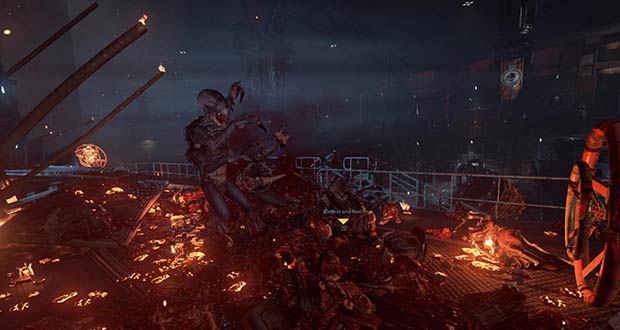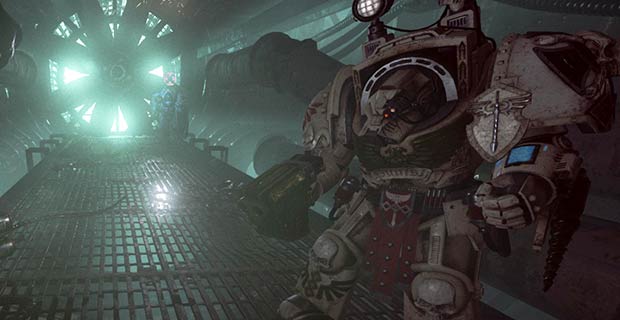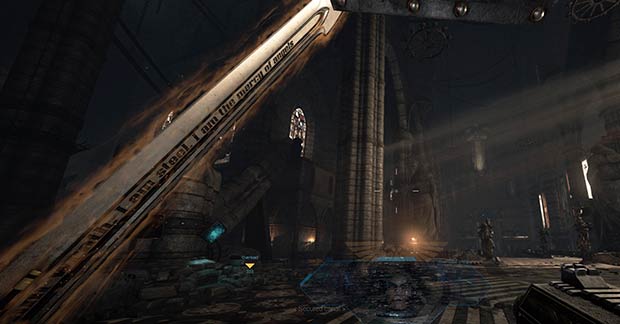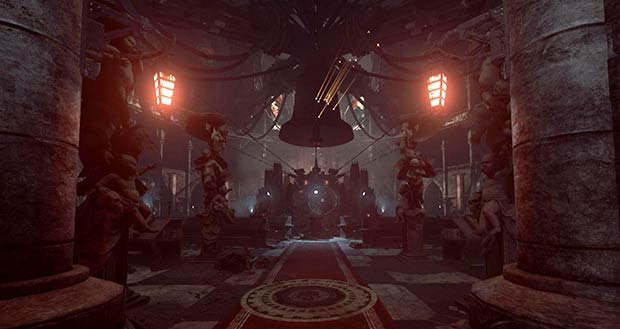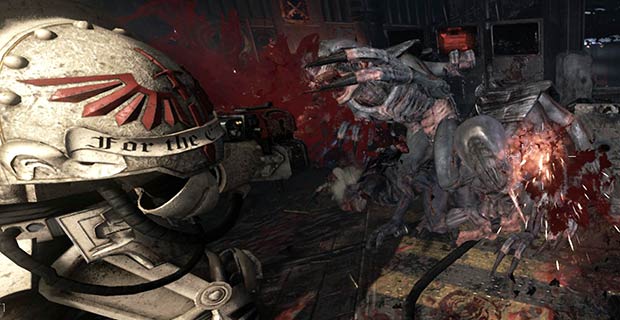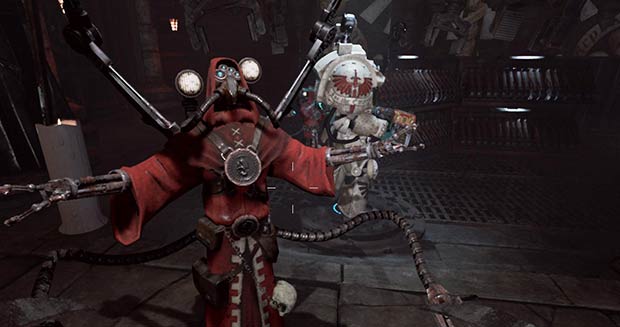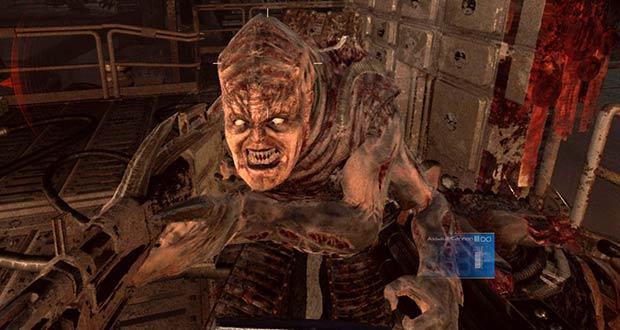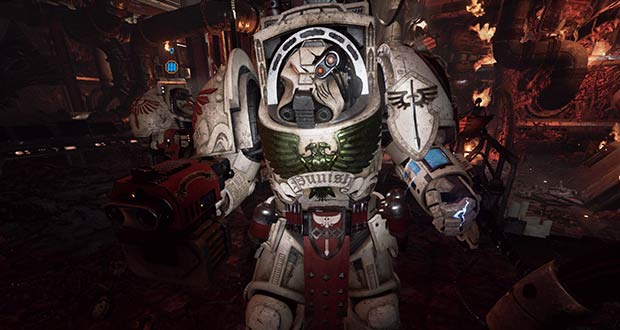Wot I Think – Space Hulk: Deathwing
SPACE HULK SPACE HU.. no, sorry, best not do that again, eh? This latest pixel-flashing rendition of the revered Games Workshop tabletop game is no boardgame adaptation, but rather a squad-based swarm-shooter in the vein of Left 4 Dead.
I played
Space Hulk: Deathwing [
official site] alone and had a lousy time. Then I played it with others and ALL GLORY TO THE EMPEROR OF MANKIND! Oops, I did it again.
Deathwing’s been presented as though it’s a singleplayer shooter at least as much as it is a co-op one, and that’s not untrue as such, but its heart just isn’t in solo play. Played alone, it’s an often tedious stomp back and forth across the same set of corridors and antechambers, with the scripts that trigger each new wave of enemies as blindingly obvious as the fact that the guy with the streaming nose and hacking cough is going to choose
you to sit next to on the bus.
Played co-op, it’s a backs-against-the-wall, teeth-gritted survival affair, knee-deep in the dead, totally dependent on each other, not caring where you are, what you have and haven’t seen already or where you have to get to – just that you have to stay alive. There is a bleak trade-off, however, and I don’t mean that seeing a Space Marine in Terminator armour who calls himself ‘ShagNasty’ rather ruins the grimdark mood. I’ll get into the critique shortly, but first let me talk about how this thing actually works.
A Space Hulk is an ancient, ruined, enormous ship/floating cathedral left, ladies and gentlemen, floating in space. At some point in the 41st Millenium, some of these great carcasses are discovered by the Adeptus Astartes of the Imperium of Man. You may know these as Space Marines. Some of the Hulks have gained new inhabitants during their long period of abandonment. They are not friendly.
They’re generally referred to as just a type of Tyranid now, but back in the late 80s/early 90s we called ’em Genestealers. They’re Aliens from Aliens, let’s be honest, but with Warhammer 40,000’s typical excess – more spines, claws that can tear through steel, four arms, infinite numbers. I love a Genestealer, me, although I’m disappointed that Deathwing’s are shades of grey, rather than the rich blues and purples of yore.
The most recent Space Hulk videogame was a broadly faithful if divisive recreate of the turn-based boardgame, but years before that we had a pair of EA games which I suppose should still be called first-person shooters, but are very, very different to what we now take that term to mean. Slower, a huge emphasis on vulnerability, and highly tactical – all about how you positioned your small squad of Space Marine Terminators, not really how well you could aim.
Deathwing is somewhere between that and yer Halos. It
is about correctly waving a targeting reticule over legions of monsters, but it’s also about working with a squad to make sure all the exits are covered, doling out healing, area of effect psyker magic and hacking doors and turrets.
There are some feints towards the tactical – follow, wait, defend, heal orders, which
are followed by your AI chums in singleplayer and may or may not be heeded by human chums in co-op. In either case, you will nonetheless be spending the vast majority of your time either stomping, shooting or stabbing.
The flow of a Deathwing mission is long periods of walking fearfully around dark, maze-like corridors, punctuated by remarkably long and vicious firefights against what can feel like an infinite swarm of beclawed horrors.
It doesn’t always feel quite right – as I mentioned above, often you can see its working, whether it’s because enemies are obviously spawning from fixed places or because it makes you repeatedly criss-cross an area in order to make an environment feel larger than it is. This is essentially a small game wearing big clothes, but what clothes they are.
There is such a thing as Space Hulkiness, and that’s arguably even more important than how well the action or the tactics are realised. Space Hulkiness is science-fiction horror, set in long and twisty corridors which occasionally yield rooms populated by either gruesome or titanic sights – viscera and giant altars, that sort of thing.
Space Hulkiness is Warhammer 40,000’s In The Grim Darkness Of The Far Future There Is Only War mantra distilled to a claustrophobic, paranoid essence – the religious-fascist fervour of the Space Marines, the indefatigable alien horde, the gothic excess of an environment that is both unspeakably huge and oppressively sealed-in.
Deathwing looks like Space Hulk box art come to life. The environments and most especially the lighting is absolutely spectacular. This is not really the sort of game where you can pause to admire the scenery, but I often did. The size, the splendour, the light, the shadow, the dark beauty of it all. Good work, Unreal engine (and artists, obviously). And it sounds like Space Hulk should too – all those sounds of metal, as the monstrously heavy Terminator armour stomps about and Genestealers sneer and snarl from the distance. The constant noise of unseen but almighty engines. The machine spirit, all around.
The downside of this is that my framerate more than halves whenever more than a couple of enemies appear – dramatically, jarringly and often to the point of unplayability, unless I drop settings to minimum even for the copious enemy-free scenes in which it’s running at a happy 60 frames on max settings.
Which sadly means that concept-art-made-flesh aspect rather loses its edge – matters become rather sludgy at lowest settings. Many players report similar framerate problems, many others say it’s absolutely fine, so I guess all we can do is hope that it turns out to be fixable bugs on certain configurations.
This issue aside, in co-op – be it with randoms or chums – the Space Hulkiness is all present and correct. It’s all about staying alive, not about finding out what happens or unlocking new weapons and abilities. The latter is there as option, by turning off Codex Rules in a match, but I much prefer having them on – no progression, everything unlocked, pick your poison. Yes, it removes a certain amount of purpose, but we didn’t need it in Left 4 Dead, did we? Sometimes it’s so much better to enjoy the ride, not get hung up on rewards.
Whatever you choose, you’ll still feel profoundly vulnerable even in your foot-thick armour and with your Lightning Claws and Bolt Guns and Plasma Cannons and Heavy Flamers and the rest of Deathwing’s small but wildly powerful-feeling arsenal.
The shooting and the stabbing or punching or chopping is breathless and intense, battles often lasting long past the point you feel is fair, and then eventually occupying a place which is appropriately Space Hulk. Sudden, punishing death is at least as important to the tone of the game as is victory. Which is not to say that it’s super-hard – unless you pick the hardest difficulty – but that it wants to feel a certain doomy way, not be unqualified slaughter.
The great downsides of multiplayer is that it removes many of the trappings of singleplayer – the cutscenes are lost, even if you have experience points and unlocks on it all gets reset come every new map, a couple of weapons are excised, as is the hacking of turrets and doors. More flesh is cut from the bones of an already lean game.
In grim contrast to that, multiplayer especially is a mess of menus and countdowns and loading screens – so much time is wasted, and even if it’s to mask necessary under-the-hood machinations, it’s done clumsily and frustrating. Once you’re in, OK, fine, but either side of it brace yourself for a whole lot of waiting for things to happen.
Unfortunately, right now Deathwing multiplayer is also prey to random crashes and disconnects, which means you often have to dance the whole dance all over again even in the space of the same play session. Given the framerate problems too, I can’t say that Deathwing is in the rude health it should be.
As for singleplayer, it is b.o.r.i.n.g. Fair play, they’ve stuck cutscenes and VO in there and it’s serviceable if unexceptional – so many 40K videogame struggle with story, as they’re not allowed to screw with the lore or adjust the essential dynamics of the endless war. You also get permanent character upgrades and weapon unlocks to pursue, so there’s a certain push to keep going.
Thing is, I think this compulsion towards progress overrides what the game is actually good at, which is shutting you inside a derelict spaceship and making you fight for your life. That itch to win things interferes with enjoying the moment. When you’ve got a thirst on for some new toy, frustration mounts at constantly retreading the same ground or being interrupted by yet another mammoth wave of ‘Stealers when you’re inches from your destination.
The squad stuff is banal and almost needless too, other than requesting healing – Deathwing can’t really be called a tactical shooter. Singleplayer felt so mechanical, so repetitive – whereas with humans and no unlocks to pursue in multiplayer, it felt tense and organic.
It does, however, effectively do just the one thing, and unless big updates are coming I suspect it’s going to wear thin. Part of me feels as though this is a brilliant, beautiful Space Hulk tech demo blown up and looped, and I’m not sure how long that can hold my interest. It’s a good time for a while, but for a long life its many rough edges need smoothing and more flesh needs adding to its bones.
Space Hulk: Deathwing is out now for Windows, via Steam, for £29.99/$39.99 (discounted to £25.49/$33.99 until Jan 2).











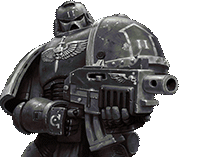








![The Year of Incline [2014] Codex 2014](/forums/smiles/campaign_tags/campaign_incline2014.png)














